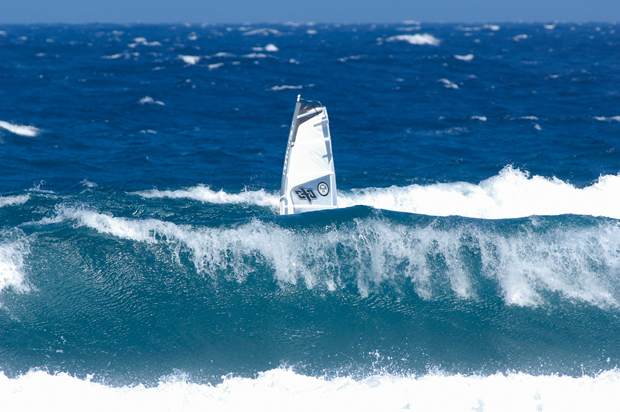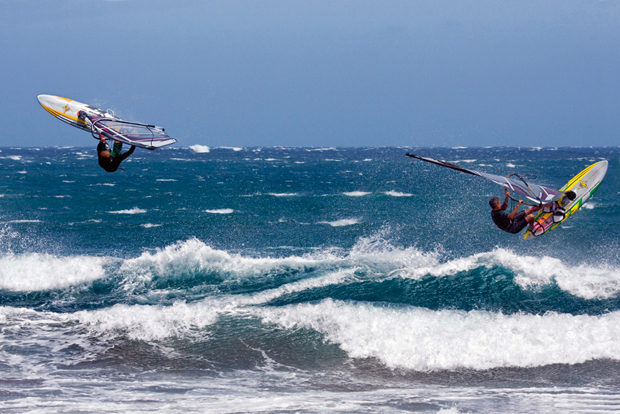
First things first. This test isn’t the definitive answer on twinsers. It’s going to take more than three weeks in (predominantly) one set of conditions to get to grips with every little nuance, strength and weakness of these new kids on the block. We’ve certainly got plenty of initial conclusions to bring you, but we intend to do a lot more testing and trialling around the twinser phenomenon over the coming months, so expect more in-depth articles to follow…
Waveboard design:
The last few years have seen more change in waveboards than any other area of board design by a country mile, and nearly all of it has been geared squarely towards improving frontside waveriding. In most respects the re-introduction of twinsers is simply the continuation of this same avenue. The major design changes thus far have been in two key areas: Planshape: Over the last half dozen years waveboards have become considerably shorter and wider (particularly in nose and tail). It has made them much looser and more manoeuvrable, as well as planing a little earlier and keeping going (flowing) better on a wave. Some of these new waveboards, ‘stubbies’, ‘onshore riding boards’, or whatever you choose to call them, have exaggerated the shorter, wider planshape to give better float, flow and looseness for lower powered riding, usually in onshore or smaller conditions.
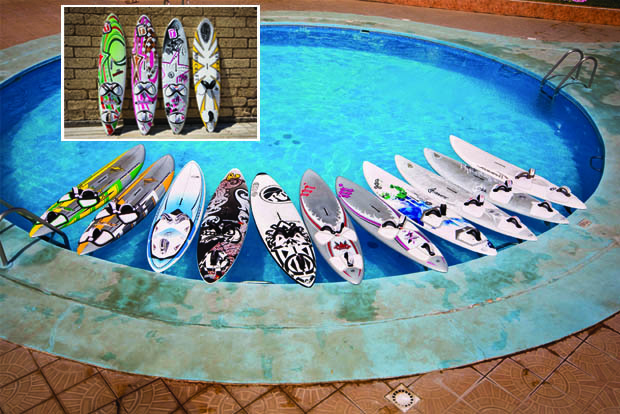
Single concave: The traditional vee on the underside has now largely been abandoned in favour of either single concave or a mix of moderate tail vee with low vee, flat or single concave going forward. This development hasn’t been quite the same win-win as the planshape changes, but has in general made boards considerably looser and easier to redirect through the turn. Unquestionably it has improved waveriding potential and made boards feel more exciting and manoeuvrable. The down side has been that it also makes boards a little harder to control, a bit harder to take upwind and not quite as easy to direct at speed onto a wave for jumping. The effects vary from board to board, but it is probably fair to say that the average modern waveboard is less controllable in harsh conditions and not much better for jumping than boards of a decade ago. They are however now far superior for frontside waveriding and, incidentally, also easier to use in moderate conditions.
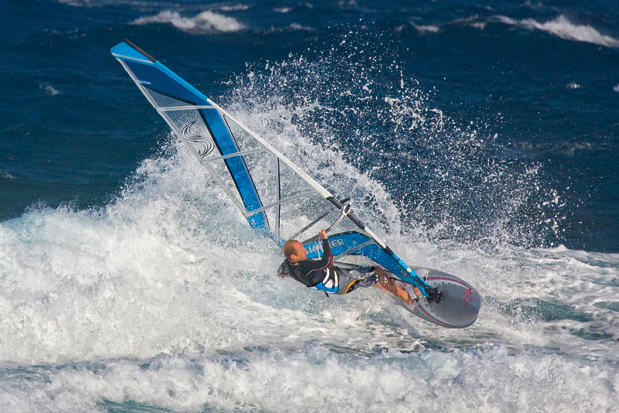
And then came twinsers:
From the start it was clear that the reintroduction of twinsers was not in any way an attempt to redress the balance towards jumping or ease of control! No, their avowed aim is to allow tighter turns on the rail to give even more radical riding.
Having now spent three weeks on them, albeit only in one place, we are confident in saying that they do seem to actually justify the general claims made for them. Yes, the twinsers we tried do, by and large, give you the potential to turn tighter and go rail to rail in smaller spaces and therefore look and feel more radical when riding. And yes, they are generally a bit harder to just get on and sail around on. Most are not quite as quick to plane as the majority of single-finboards and not quite as easy to take upwind or jump.
The scale of both the advantages and disadvantages they bring has probably been exaggerated by hearsay and speculation, but there is truth in them. We’ll look closer at their designs and effects in a minute, but first we want to put a little context around them. Twin-fin boards are designed to aid waveriding. So the only reason to buy a twinser is if you are a keen and relatively experienced waverider looking for better riding at the expense of jumping. The ones we tested will not really help the learning process of waveriding, unless you are already capable of going frontside in a committed fashion – and in onshore conditions that means a very high level of competence. The majority of people who go out in waves around our coasts in a Force 5-6 will still be better off with a more all-round board. Even those committed to improving their waveriding will be better off with a more user-friendly single-fin until they have improved.
However, if you are capable of getting near vertical when frontside riding – either because you are a very good sailor in onshore conditions, or a good sailor lucky enough to regularly sail in cross or cross-offshore conditions – then you definitely qualify for a twinser. We have spoken to a number of very good sailors who are genuinely enthused by the boost that twinsers have given their riding. They feel pushed by the potential of their new boards to explore the tighter more vertical riding style they allow and have found new enthusiasm because of it. Nevertheless, it’s still not quite as cut-and-dried as ‘hot sailor = twinser sailor’. It should be an additional purchase rather than taking over as your only waveboard, since they do have such a strong bias towards riding, and even then there are still some types of riding where a twinser won’t necessarily be the best choice.
And the rest?:
Fortunately for all of you who aren’t in the twinser-buying bracket, we also have plenty of great boards in the line-up here to cater for all the other types of waveboard buyer. Really great boards. Unlike the twinsers, which are all ‘first generation’ designs, the single-fin boards on test here are extremely well-proven and finetuned shapes resulting from years of development, and offering just about the best of any type of blasting, gybing, jumping and riding performance you could wish for. And this test throws up just about every type of board imaginable, which is great! You can no longer lump most waveboards into two categories such as ‘stubby’ or ‘trad’. They now span every conceivable combination of design features. Some are still clearly ‘stubby’ (short with wide nose and tail) such as the F2 Rebel or Tabou Pocket Wave, though none are now recognisably ‘trad’. Some have narrow tails or narrow noses and some are a bit longer or shorter, but there is little pattern. Likewise the rockerlines vary hugely. For example there are now fast-rockered stubbies, and slow-rockered stubbies, as is the case with the boards of a more conventional planshape. The same is true of vee: although the majority of waveboards are now low vee or single concave, there are still plenty around with moderate vee.
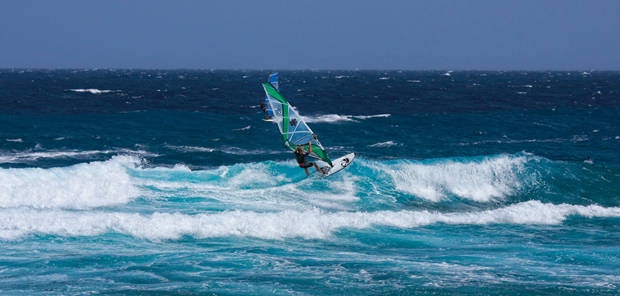
These variations have significant effects on the performance of the particular boards and the choice, although it can be a little confusing, is rich. So, in short there is a wealth of excellent and diverse boards among those tested here, as well as many others that didn’t arrive in time for the test or we didn’t have space for. And anyone looking for all-round wave performance, or not of a very competent riding standard, will be considerably better off choosing from these rather than the twinsers on test here. The twinsers on test We had four twinser boards on test. The Fanatic, JP, Mistral and RRD. We want to stress immediately that although they are lumped together here as twinsers, it’s not just because they’re the boards with two fins. Number of fins is just another feature that could be used to classify boards, and in our view is certainly not the most important. It would be equally as or more relevant to group them by planshape, rockerline or underwater shape (concave or vee), in our view still the three main distinguishers of waveboard performance.
The reason we can group the twinsers together is because they have a lot more in common than two fins. They all have a very similar planshape with relatively short length, relatively narrow tails and relatively wide noses. The impetus for the development of these boards was the stir caused by Kauli riding large, well formed waves in such a tight, curvy, flowing style.
It is then no coincidence that these boards have planshapes capable of handling the speed and power of bigger waves (i.e. narrow tails). However, in our view this is not driven by the peculiar properties of the twin-fin arrangement. While carrying out the testing we were able to use a fifth twin-fin board with a clearly wider tail (and nose), more of a twinser stubby if you like, and the advantages of the twin-fin arrangement were just as relevant to this board.
So while this test features boards with planshapes more geared towards faster riding, the twin-fin arrangement is by no means necessarily only relevant to one type of planshape, or for that matter to one type of rockerline or underwater shape… Isolating the properties of the twin-fin Our plan was to compare the new Tabou Da Curve twin-fin 73 with last year’s Tabou Da Curve single-fin 73. The board shapes are identical but one is a twinser, giving the perfect opportunity to pin down exactly what performance aspects were attributable to the fins alone. Unfortunately the twinser only arrived in time for a day of 5.2m wind, and it is a small, narrow board (53.5cm) with plenty of rocker, so we weren’t able to compare them in wellpowered, small sail conditions, or – frustratingly – on a decent wave.
Comparing them side-by-side for sailing, the differences were surprisingly small. The twinser basically felt as if it had a slightly smaller fin. You had to be a bit more careful how you trimmed the board and it felt a bit more skatey on the tail, but in practice neither board seemed to have an advantage going upwind. However, much of this lack of difference is almost certainly simply due to the fin sizes. The single-fin had a relatively small foil (20cm), and the twin-fin had relatively large fins (16cm), and definitely felt the most powerfully-finned of the twinsers anyway. Which shows that, just as with a single-fin board, you can (if you have them) put larger fins into your twinser to give you more drive should you need it.
As for turning, the gybing performance was very similar. When riding, it seemed that the twin-fin arrangement gives a bit more reliability in tight, fast turns on the rail, for two almost contradictory reasons. Firstly because at times there isn’t quite the same depth of fin lifting the tail out of the water and because at other times there conversely is a fin, albeit not as deep and not creating excessive lift, in the water at all times. (Sometimes a single-fin will pretty much come completely out of the water in a hard banked turn.)
As concerns jumping, it does seem that you can kick harder into take-off with a single-fin. Although the lift for getting upwind might be very similar there is a slight extra feel of solidity that seems to come from having a bit of fin 6-8cm deeper in the water, where it is perhaps less cavitated and denser.

In Conclusion: Our initial feelings then are that, all other things being equal, the twinser fin arrangement in isolation doesn’t make that much difference. Boards feel a bit less positive and directional when going upwind or just blasting along, but (depending on fin size) it doesn’t seem to handicap them greatly. They have a slightly less positive attack into jumps, but are slightly quicker in responding to steering input and slightly better able to carve tight on tail / rail at speed.

About the test:
The test was carried out at El Médano in Tenerife at the OTC test centre where the majority of these boards are now available for you to test yourselves, for the price of an air ticket and a couple of days board hire! Once again we’d like to thank Ben and Tris and the boys from OTC for sorting us out while we were there. Check out www.otc-windsurf.com for more information on their holidays and equipment. OTC do also have the new Starboard Kode and Evil Twin in stock. Unfortunately at present Starboard have requested that we do not test their boards, which is why they weren’t in the test line-up. Conditions: The late July and early August winds were as consistent and reliable as ever giving us a preponderance of 4.7mand 5.2mwinds with a few days of 4.0m thrown in to keep us exhausted. The waves on the harbour wall were of a useful size (occasionally overhead) but the winds there are always cross-onshore making the riding technically quite difficult and favouring boards that turn easily and keep speed up over slower boards. Arguably this didn’t particularly favour the twinsers which would very likely fare better in more cross-shore conditions. However, conditions were easily good enough to give all the boards a good chance and are fairly representative of the more common riding conditions around UK shores. The testers were Emile Kott, Mark ‘Sparky’ Hosegood, Ian Leonard and Ed Frisby.
The twinsers on test:
The relatively short length and high rockers of the Fanatic and JP and the very short length of the Mistral meant the majority of twinsers were comparatively a bit more technical to sail than the single-fins. After a session on these three boards, working hard to get upwind for the next ride, you come in pretty tired. There is a greater sideways component of pull and our arms felt a bit longer at the end of the day! There has been much talk that the twinser arrangement allows you to handle a bigger board and maybe the tiring factor would have been less noticeable with the next sizes up, and maybe it would have been easier to keep speed up on the wave. Probably, in onshore conditions with the more highly rockered boards this would indeed be the case, although the Fanatic is quite voluminous anyway.
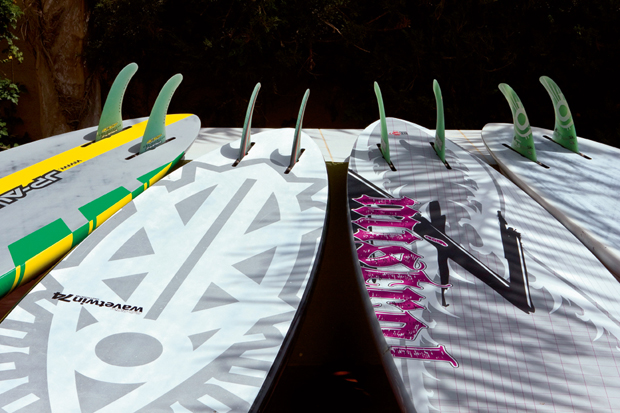
Of the four, the most universally popular in the conditions we had seemed to be the Mistral. Its very short length makes it technical to sail but it has a fast rocker and keeps speed well. It is the only one to have vee and this makes it feel very positive in the turn, really squirting it through the carve, albeit in a slightly more predetermined arc. It is very tight and sharp when you get it right and is perhaps the best jumping board of the four The RRD also has a faster rockerline and it feels the most conventional to sail, keeping upwind and jumping pretty well. It is certainly the most user-friendly of the twinsers, and seems the best of the bunch for easy riding in smaller waves. It doesn’t require the same commitment from the rider to get nice flowing turns on onshore waves as the other twinsers, but doesn’t turn as hard when fully committed.
The Fanatic and JP are both more highly rockered, single concave boards and more riding-biased. Both had their moments in the onshore Médano surf and showed that they can really rip, and we feel that both would come alive in more cross or cross-off conditions. Of the two the JP feels a bit sharper, faster and more edgy on the wave, while the Fanatic feels a bit smoother and easier. With its higher volume it feels a little quicker to plane and easier to sail.
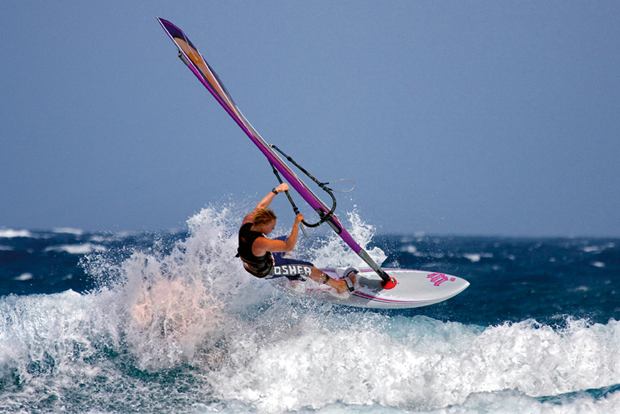
Mark Hosegood on Twinsers:
We were lucky to have an excellent wavesailor help us test the twinsers in the shape of ‘Sparky’ Hosegood. It was his first introduction to the boards and having tried them out he had the following thoughts: “They seem to make waveriding easier. You never trip a rail and they turn very easily and allow you to go radical, vertical and changing carve and with good snap. They keep speed when going vertical. They are not as efficient sailing along but not that bad either. Not as much push or pop off the back foot but they generally go upwind OK. Bigger ones should be OK for people learning to waveride, though not for entry level wavesailors. “Would I get one? Yes, I’d get one for its riding potential, possibly the Mistral.”
Comparing the rest:
OK, now on to the other ten boards in the test! Four stood out as being very similar in type, and in offering a very well-balanced mix of performance qualities for a waveboard. Indeed, all four are remarkably recommendable boards, all of which we would be very happy to have in our quiver. They are the Fanatic New Wave, Mistral Wave RD, RRD Cult Wave Hardcore and Thommen MWX. All of these are fairly conventional waveboards in that they have relatively narrow tails and noses and are not especially wide (all 54–55cm at max). All four offer either single concave or a combination of moderate vee and concave going forward. They are designed to give a wide wind-range spread, and to be versatile, ‘do it all’ waveboards; more or less equally happy jumping, blasting, riding or gybing.
They are a very good option for anyone expecting to use them in strong winds as well as medium winds and in a range of sea conditions. Of the four the Fanatic and Mistral are slightly wider (and thus effectively bigger boards) but have average wave rockerlines, while the Thommen and RRD are narrower but have slightly faster rockerlines. The Fanatic feels the most radical, lively and loose but is slightly harder than the others to sail, while the RRD is not at all dissimilar but slightly quicker to plane (for its size – though the RRD 75 would be a much better like-for-like comparison) with a similar very lively single concave feel. The Thommen and Mistral are both slightly easier to sail and again very similar, with the Thommen feeling a bit faster and more dynamic and the Mistral a bit looser. All four are cracking boards.
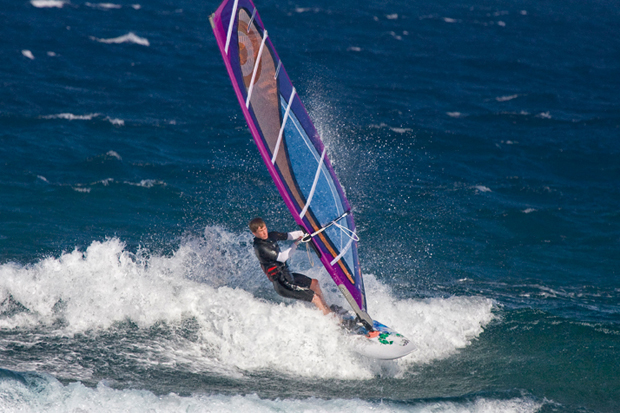
The Exocet X-Wave is not dissimilar to the above boards in being a very good all-rounder for a range of wind and water states. It too is quite narrow (54cm) but it has a wider tail and a faster rocker than any of the above. As a result, although it is a capable riding board it is certainly less loose than most here. Its strength is as more of an ‘all action’ blaster / jumper / gyber.
The remaining boards are all a bit wider. Three could loosely be described as stubbies. The F2 Rebel is a classic stubby, short with a wide nose and tail, average wave rocker and vee going to single concave giving very loose, easy and very onshore friendly riding as well as good performance in more moderate to medium waveboard winds. It is certainly a slightly riding biased board but not to the same extent as some other higher rockered, more single concave stubbies, and it gives good all-round performance and seems to be well liked by all who try it.
The JP Real World Wave has a similar stubbyesque planshape but without the very wide nose and it features considerably more rocker through the tail. It therefore doesn’t have the same performance in moderate winds or the same flow and top turn power in slower speed onshore riding, but it is more agile and controllable in higher winds. It has the same good weight carrying capabilities but is designed for a higher wind range or slightly more powerful waves, and will be a particularly good choice for heavier or less confident sailors wanting a user-friendly high-wind board. It too slightly favours riding over jumping.
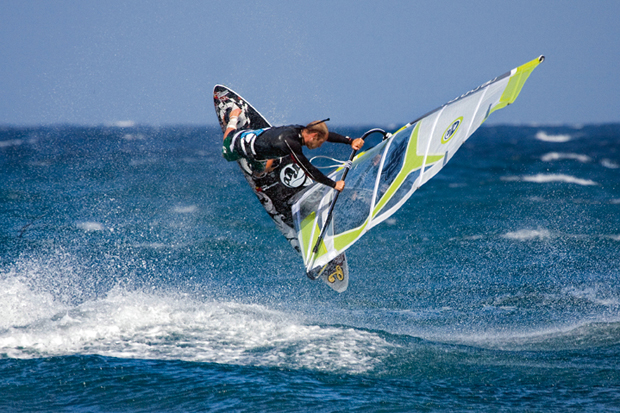
The third stubby is the Tabou Pocket Wave. Although not particularly wide at 55.3cm it has an exaggeratedly stubby planshape (like a Weetabix) and a fast wave rockerline. We haven’t used it as much as the other boards but are very impressed with its sprightly and manoeuvrable yet surprisingly all-round performance with a 5.2m. Another good bet for the less experienced wavesailor too, thanks to its very user-friendly performance.
The new Goya One is similar in fast rocker to the Tabou but more of a conventional shape. It is not as loose on a wave or quite so agile and direct underfoot but it is extremely easy to sail, has an excellent wind range and performs well both jumping and riding. It’d make a cracking first time waveboard, or general high-wind-board. Finally, the Witchcraft is like an extreme stubby with a slightly narrower tail. It has a very skatey, loose feel underfoot but gives good speed and acceleration. It gives good potential for both jumping and riding but is not an easy board to master.
IN CONCLUSION:
On the basis of this test our expert, Sparky was the only one ready to commit to getting a twinser. The rest of us saw the potential, saw the waveriding possibilities, but didn’t feel ready to commit. This is largely because none of the twinsers on test seemed quite good enough compromises for all-round wavesailing, and none of the testers regularly do more than about 40% frontside riding in a normal session, and can’t really afford to run too large a waveboard quiver. Obviously though, if the kit budget were bottomless…
More riding-focused sailors would certainly feel differently. And our views could easily change with the next batch of twinser boards which may have more all-round appeal. Or we might find ourselves getting accustomed to them and more appreciative of their qualities, or find we get more from bigger sizes.
In actual fact, the really big news from this test is the superbly high quality of the allrounders on test here, as well as some of the faster rockered and stubby boards. Even though some of these shapes and all the design elements are a season or more old they feel totally fresh and we are still growing into them and loving them. It almost seems a shame that the twinsers are already taking attention away from them before the public at large has possibly really appreciated the wealth of performance modern waveboards now possess. Most of the market is fairly static but the waveboard sector is positively brimming with development. If you’re thinking about a new waveboard, then your options have never been better!

